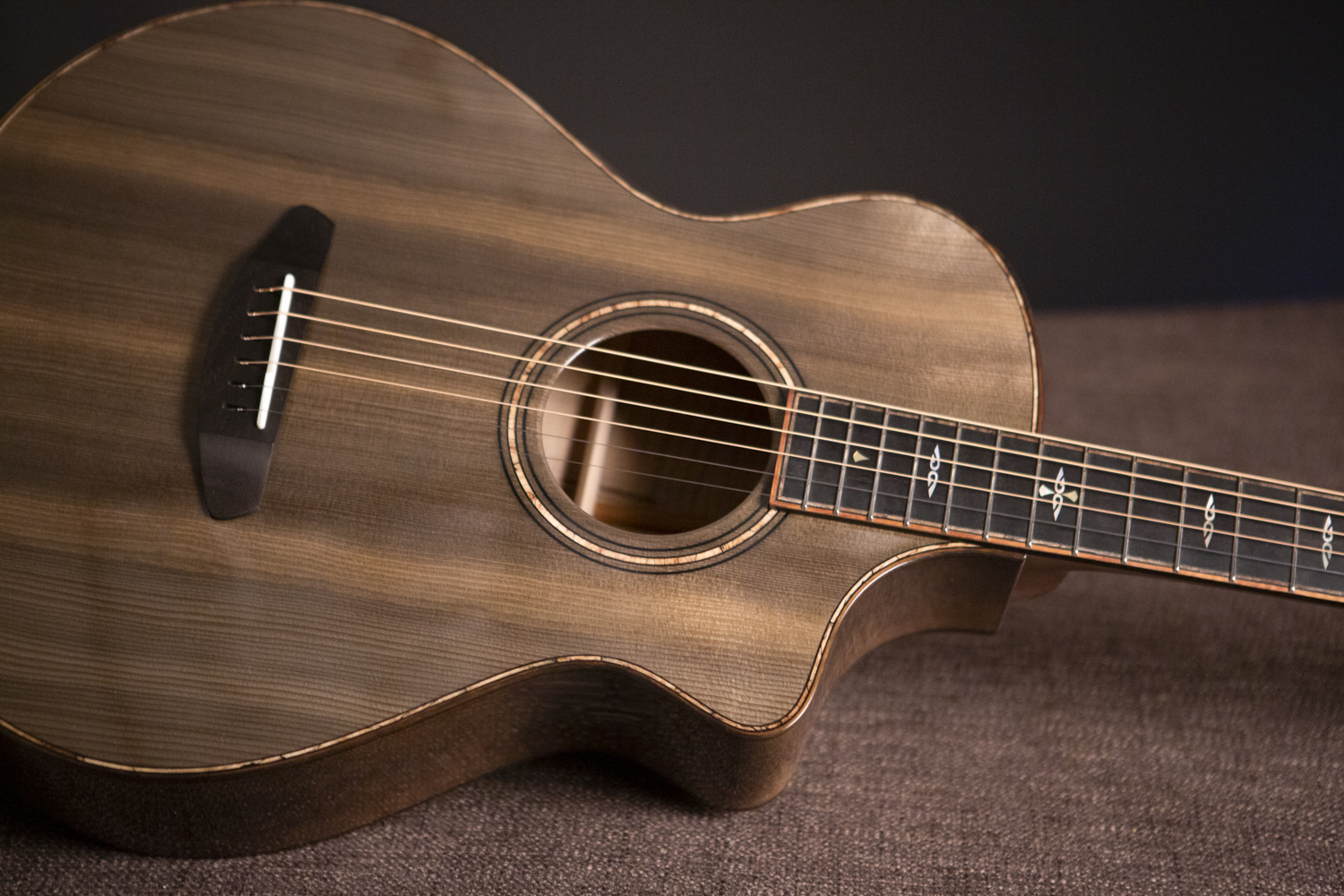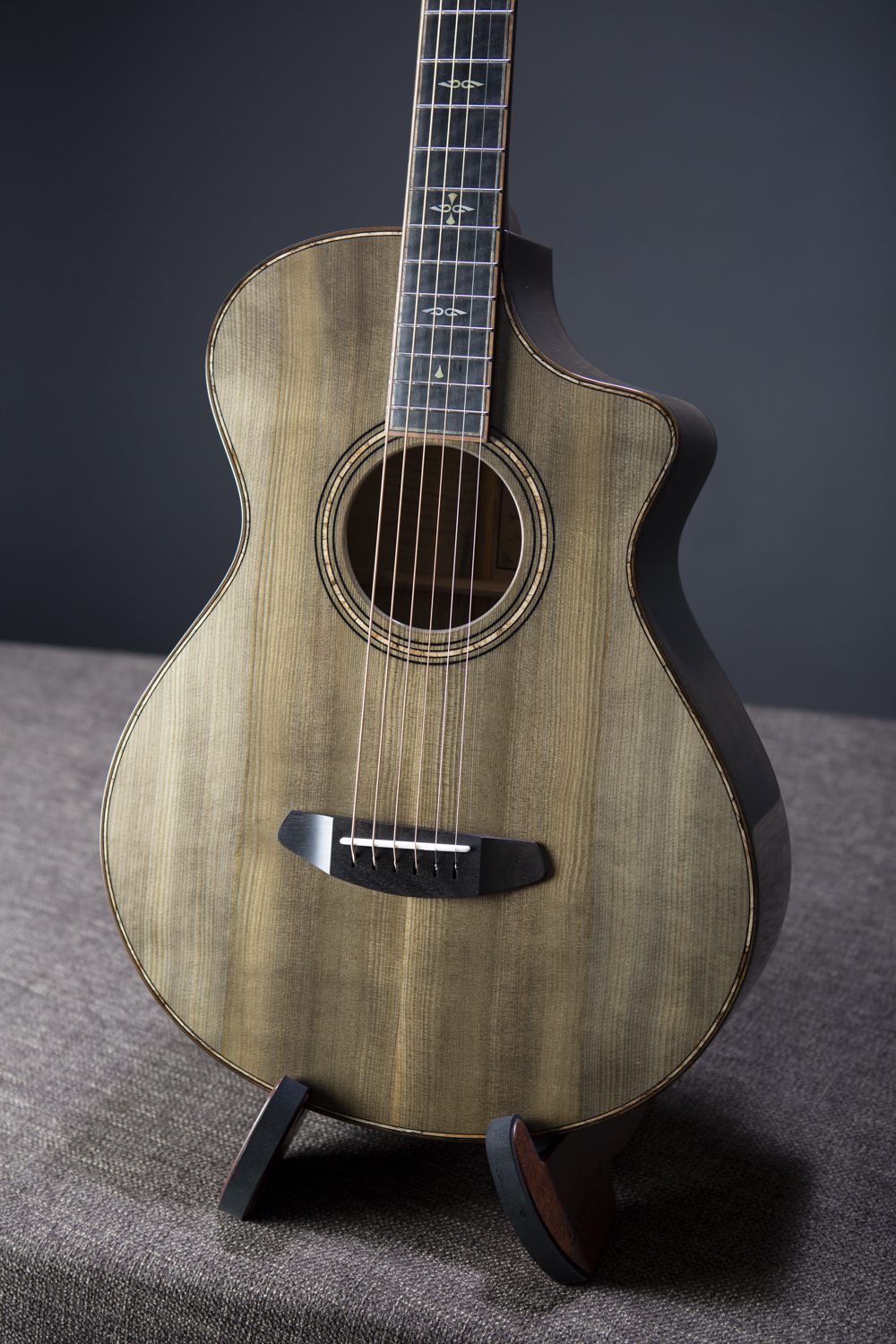

Breedlove Owner Tom Bedell with an Ancient Stika Spruce guitar.
Three thousand years ago, around 1000 B.C., the world’s human population was roughly 50,000,000. In North America, hunter-gatherers still stalked mammoths and giant bison grazing in the lush and untouched nature across North America. In Southeast Alaska, the great coastal forests were largely untouched by the hand of man. It was here, on the steep slopes miles from what is today Craig, Alaska, that an iconic tree underwent an incredible chain of events that would link it to modern guitar centuries later.
While no one was around to know exactly what transpired, we can only dream that one night during this era, a violent storm hit the steep slopes and pummeled the forest towering within view of the coast. Heavy rains saturated the soil, loosening the roots of one towering old-growth Sitka spruce. As the winds raged through the treetops, a soon-to-be-famous tree fell, only to be buried in a landslide as the slope gave way. For millennia, this Sitka remained buried in the mud, rocks, and debris, until Brent and Annette Cole, the owners of Alaska Specialty Woods, began excavating their property to build a new workshop – at the exact final resting place of this soon to be famous tree.
While it’s probably not uncommon for people excavating in this region to unearth buried and ancient parts of the forest while digging for construction purposes, what’s particularly fascinating about this find is the Cole’s trajectory in life and business are intricately tied to Sitka Spruce – along with other local species – which they have carved a niche selectively and sustainably harvesting in the region. It’s ironic to think a family who’ve been devoted to seeking out rare and iconic old-growth trees happened to find The Holy Grail buried on their very property—buried for centuries, just waiting for them to unearth the magnificent tree and bring it to the world of high-end guitars.
As they were digging and flattening the area where they planned to build, the Coles at first found a Hemlock root wad. In an effort to move it, they cut the roots off—but were shocked at what happened next.
“I saw it turn blue and that it was sound as a nut. At that point, I took an 18-inch round off of it, took it to the saw, and sliced it into ukulele and mandolin tops. [I thought] ‘Wow, these are cool!’ They got snapped up on our website right away,” said Brent Cole. “Then we were [excavating] more, and we found the Sitka spruce.”
After the surprise the Hemlock gave them, Cole was intrigued to see what the Sitka had in store—but knew he would have to take an expensive gamble to find out.
“I had to make a determination on whether or not we wanted to mine that log out or not,” said Cole. “We’d spend a day digging that thing out—it’s about 20 feet below the surface. To move that much material—because you can’t jerk it out, you have to dig it out—[was a matter of] $3000 in equipment time. So, it was a gamble, but I decided to take it.”
 The tree was unearthed and cut, and it too possessed that amazing otherworldly ability to turn an incredibly unique blue-green right before their eyes. Cole says this color change is caused by oxidation, but the appearance of the green-blue color in the Sitka is something especially rare and unique to Prince Edward Island. Apparently, the mountainsides of Southeast Alaska are highly mineralized rainforest, and the whole mountain by the Coles’ property is covered in iron seeps. So, it’s the dominance of the iron in this area that lends this particular Sitka, which is historically a light blonde wood, such a strange, otherworldly hue.
The tree was unearthed and cut, and it too possessed that amazing otherworldly ability to turn an incredibly unique blue-green right before their eyes. Cole says this color change is caused by oxidation, but the appearance of the green-blue color in the Sitka is something especially rare and unique to Prince Edward Island. Apparently, the mountainsides of Southeast Alaska are highly mineralized rainforest, and the whole mountain by the Coles’ property is covered in iron seeps. So, it’s the dominance of the iron in this area that lends this particular Sitka, which is historically a light blonde wood, such a strange, otherworldly hue.
So, the Coles’ gamble paid off, if you can call it that. The fact that the motherload of all Sitka tonewood just happened to be found beneath the property of a family-run company that has spent more than twenty years salvaging the finest Sitka tonewood, seems more like divine intervention than luck.
Even more serendipitously, Bedell has long-sourced many special tonewoods, including Sitka spruce, from Alaska Specialty Woods, and was one of the first to hear about the Coles’ discovery. Shortly after getting the call, Angela Christensen, Bedell’s Head of Product Design, took the long journey out to the Cole’s property, nestled on a waterfront inlet in remote Craig, Alaska, to have a look at it for herself.
“They had the log in their log yard, and Brent Cole’s son, Brent Jr., made a cut in the log around 24 inches,” said Christensen. “As they made the fresh cut, it looked like normal Sitka. And then he pulled another section off, and in front of my eyes, I could see it changing color. It was amazing to see the change from the creamy white to the really beautiful green-blue-grey colors. How cool is that!?”
Christensen and the Coles quickly realized that this striking wood was destined for a unique limited line of guitars that showcased its rare look and sound—although there was only enough wood for a few of them.
Not only would the ancient Sitka make for jaw-dropping pewter-patinaed tops, but when it comes to its use as a tonewood, this wood has quite literally aged to perfection. Sitka spruce, a magnificent tree with tight grow-rings and a dense composition, is already ideal for a beautiful, crisp acoustic sound. But this ancient Sitka, rich in minerals, pushes those optimal tonal properties even further.
“The difference is that it has absorbed the iron mineral content from being buried in the soil, which does tend to stiffen the top a little more, that it has more headroom,” Christensen said. “And it still has all of what you’d expect out of Sitka, delivering crisp, clear notes, but with a little extra punch in sound. This makes it ideal for players with a stronger attack.”
With its singular, winsome appearance, sound as strong and wise as its years, and captivating history, this Ancient Sitka is the embodiment of wonder. It permeates every note, every strum—with timeless magic.
